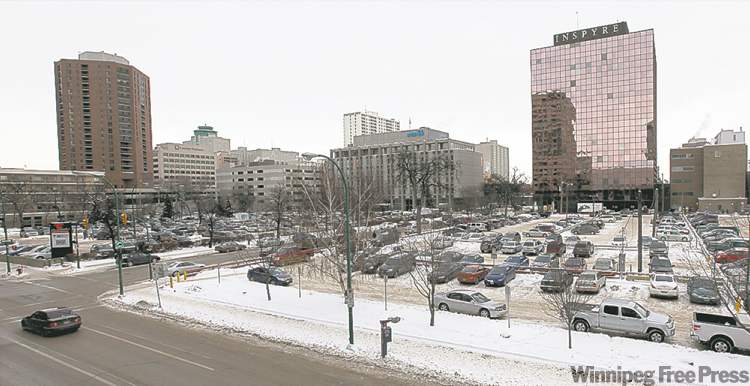What drives change?
Experts mull carrot or stick approach to ridding downtown of lots
Advertisement
Read this article for free:
or
Already have an account? Log in here »
To continue reading, please subscribe:
Monthly Digital Subscription
$1 per week for 24 weeks*
- Enjoy unlimited reading on winnipegfreepress.com
- Read the E-Edition, our digital replica newspaper
- Access News Break, our award-winning app
- Play interactive puzzles
*Billed as $4.00 plus GST every four weeks. After 24 weeks, price increases to the regular rate of $19.00 plus GST every four weeks. Offer available to new and qualified returning subscribers only. Cancel any time.
Monthly Digital Subscription
$4.75/week*
- Enjoy unlimited reading on winnipegfreepress.com
- Read the E-Edition, our digital replica newspaper
- Access News Break, our award-winning app
- Play interactive puzzles
*Billed as $19 plus GST every four weeks. Cancel any time.
To continue reading, please subscribe:
Add Winnipeg Free Press access to your Brandon Sun subscription for only
$1 for the first 4 weeks*
*$1 will be added to your next bill. After your 4 weeks access is complete your rate will increase by $0.00 a X percent off the regular rate.
Read unlimited articles for free today:
or
Already have an account? Log in here »
Hey there, time traveller!
This article was published 08/12/2010 (5416 days ago), so information in it may no longer be current.
Thirty years ago, Harrisburg was one of the most blighted cities in the United States. Pennsylvania’s capital city had an outrageous crime rate, its population was plummeting, and its downtown was plagued by porn shops, boarded-up buildings and vacant land.
Now, thanks in part to an unusual tax regime, it’s a model of downtown redevelopment in a state known for innovative urban planning. It’s a restaurant hub. It’s got a new college campus, several new high-end hotels, and a hipster nightlife.
Harrisburg also has a hybrid version of the land value tax, in which property owners pay taxes on the value of the land, not the buildings on it. It’s used in several European countries and some U.S. cities to punish developers who leave their land fallow and reward those who build vertically.

Some say that’s the sort of stick Winnipeg needs to use to deal with more than 154 surface parking lots that plague the downtown, creating dead zones that make the core seem deserted and dangerous.
Instead, Winnipeg Mayor Sam Katz has opted for a carrot similar to the tax breaks used in many other American cities. Katz has said surface lot owners who build up will get a five-year tax freeze even though their property values increase.
But a panel of parking experts convened last January to review Winnipeg’s parking strategy recommended a more radical approach — imposing higher property assessments on surface parking lots to encourage building. Urban planners and many commenters at winnipegfreepress.com have made similar suggestions such as a surtax on surface lots.
Hart Mallin, a developer and outspoken downtown advocate, says taxing surface lots to death could have some ugly short-term spinoffs. High taxes will trickle down to parkers, forcing up the price of a spot and driving people, especially shoppers, to the suburbs where they can park for free.
Mallin said it makes more sense for the city to buy some surface lots and sell them at a dramatically reduced rate to a developer willing to build housing or mixed-use buildings.
“Sell it to a good builder, sell it for half and let’s start really doing something,” said Mallin.
With interest rates still at very low levels, Mallin said, it even makes sense for the city to borrow strategically to buy lots right now, knowing future tax revenue will likely cover the debt.
CentreVenture president and CEO Ross McGowan said the downtown development agency is looking to begin land assembly in the new year, though he wouldn’t say what lot or lots he is eyeing or what the development process might entail.
Several years ago, CentreVenture spearheaded the condo developments along Waterfront Drive, many of which were built on gravel wastelands then used mainly for parking.
McGowan also said the key to downtown development, including on surface lots, is a real plan for an area on which developers can bank. Right now, CentreVenture is focusing almost exclusively on the Main Street and Portage Avenue corridors.
Surface parking lots present a particularly intractable problem. Lots are profitable, unlike vacant buildings such as the Avenue Building where the taxes, upkeep, and liability insurance are steep enough to make redevelopment more attractive. The high tide of a hot property market will eventually lift surface lots, but not until it’s lifted all the vacant buildings downtown.
Several urban planners said the long-term solution is to decrease demand for downtown parking by getting Winnipeggers out of their cars and onto the bus or light rapid transit, a process that’s been stunted by decades of dithering over rapid transit.
Winnipeg is 30 years behind other Canadian cities and won’t have a sophisticated rapid-transit system for at least another decade.
maryagnes.welch@freepress.mb.ca
Downtown Winnipeg's Surface Parking Lots
Publicly owned lots are indicated by red pointers; private lots are indicated by yellow pointers.
We’ve endeavoured to ensure the map pointers are roughly accurate, but they may not be precisely on a lot’s location due to limitations of Google's mapping technology. Please help us improve the database by alerting us to omissions or mistakes via email or the comment box below. The text version of this database is also available online.





